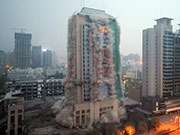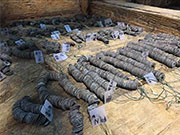

Severe pollution blankets landmarks in the capital on Tuesday, including (L-R) the China Central Television building, Forbidden City, Beijing National Stadium and Beijing West Railway Station. The images provide a sharp contrast to days with a clear blue sky. Photos on iPad are provided to China Daily by Tao Yuan, Hu Qingming, Li Junfeng and Nipic.com. ZOU HONG/CHINA DAILY
Pollution likely to be at its worst on Wednesday, remain hazardous for days
Heated debate raged among Chinese experts on Wednesday over why severe pollution is being seen more frequently in China.
As dense smog continued to shroud Beijing, most experts blamed the widespread use of low-quality coal for home heating during winter-on top of heavy industrial discharges and vehicle emissions.
Dense smog was affecting northern areas of the country, crippling industry and transportation and affecting more than 300 million people.
The smog is expected to reach its worst levels on Wednesday before beginning to lessen later in the week, but will probably remain hazardous until Saturday, the Ministry of Environmental Protection said.
Apart from Beijing, Dingzhou and Xinji in Hebei province have also issued red alerts-the highest-for the first time. Lower-level alerts have been issued in Tianjin and in other parts of Hebei, as well as Henan, Shandong and Shanxi provinces. Tianjin is under an orange alert, the second-highest level.
Another 27 cities have raised local alerts, including Shijiazhuang, Zhengzhou, Jinan and Taiyuan, the capital cities of the four affected provinces.
A series of emergency pollution control restrictions have been introduced, ranging from closing industrial operations to reducing road traffic by half. Beijing's vehicle restrictions will last until noon on Thursday.
Although coal-burning is strictly banned in downtown Beijing and some of its suburban areas, coal is still being used for home heating in all rural areas of the smog-affected northern provinces.
Experts and the national environmental watchdog said the soaring use of coal and industrial pollution are the main reasons behind the severe smog affecting northern areas.
Xie Shaodong, an environmental professor at Peking University, said: "The main cause is the widespread use of low-quality coal in rural regions and in areas with a lack of environmental supervision."
Chai Fahe, deputy director of the China Research Academy of Environmental Sciences, said that even in distant suburban areas of Beijing pollution remains heavy because coal is used for heating and rules are not being enforced strictly.
Feng Yinchang, an environmental professor at Nankai University in Tianjin, said the use of low-quality coal in rural areas is a key source of winter pollution.
Tao Guangyuan, executive director of the Sino-German Renewable Energy Center, said vehicle exhaust emissions are "not that bad" because most Chinese vehicles use similar standards governing petrol that have been adopted in developed countries.
According to environmental authorities, the main source of pollution in Beijing is vehicle exhaust, while in Tianjin it is dust. Coal-burning is the chief culprit in Shijiazhuang.
The authorities have been leading an initiative for high-grade coal to be used along with less-polluting boilers in the countryside. But experts say it is hard to check the day-to-day situation in all villages.
 |
Day|Week

 Spectacular aerial photos of the Three Gorges
Spectacular aerial photos of the Three Gorges New balls please! Polish sports stars strip off for risqué calendar
New balls please! Polish sports stars strip off for risqué calendar A glance at life of Ukrainian models working in Chongqing
A glance at life of Ukrainian models working in Chongqing Contestants of Mrs. Globe pose for photo in Shenzhen
Contestants of Mrs. Globe pose for photo in Shenzhen
 Bikini models attend hot pot banquet in Hefei
Bikini models attend hot pot banquet in Hefei 118-meter-high Never-used Building in NW. China Demolished
118-meter-high Never-used Building in NW. China Demolished J-10B fighters with homegrown engine in test flight
J-10B fighters with homegrown engine in test flight 10 tons of copper coins unearthed in 2,000 years old ancient tomb
10 tons of copper coins unearthed in 2,000 years old ancient tomb Beautiful graduate from police college becomes Internet hit
Beautiful graduate from police college becomes Internet hit Photos of U.S. Navy intruding in South China Sea released
Photos of U.S. Navy intruding in South China Sea released